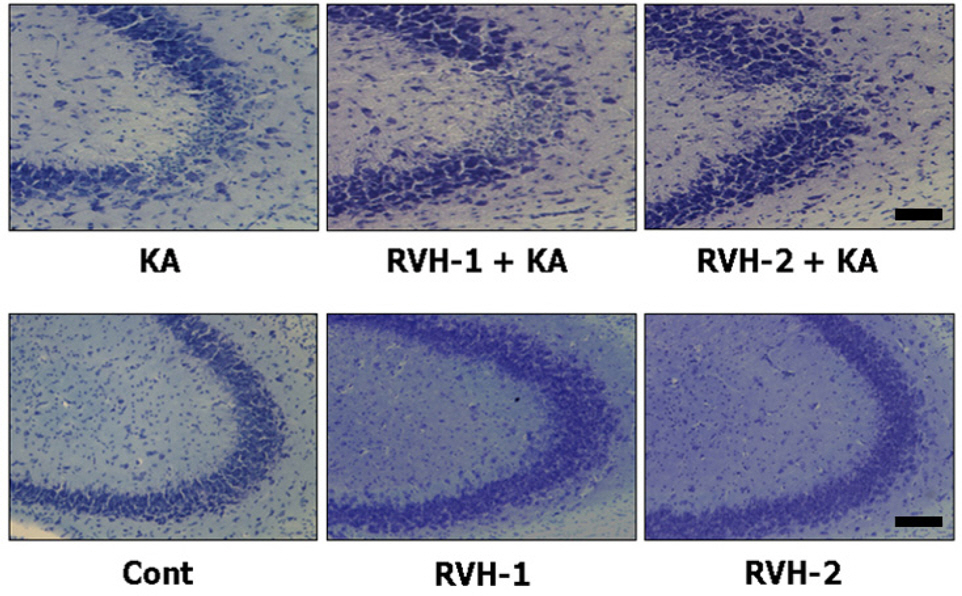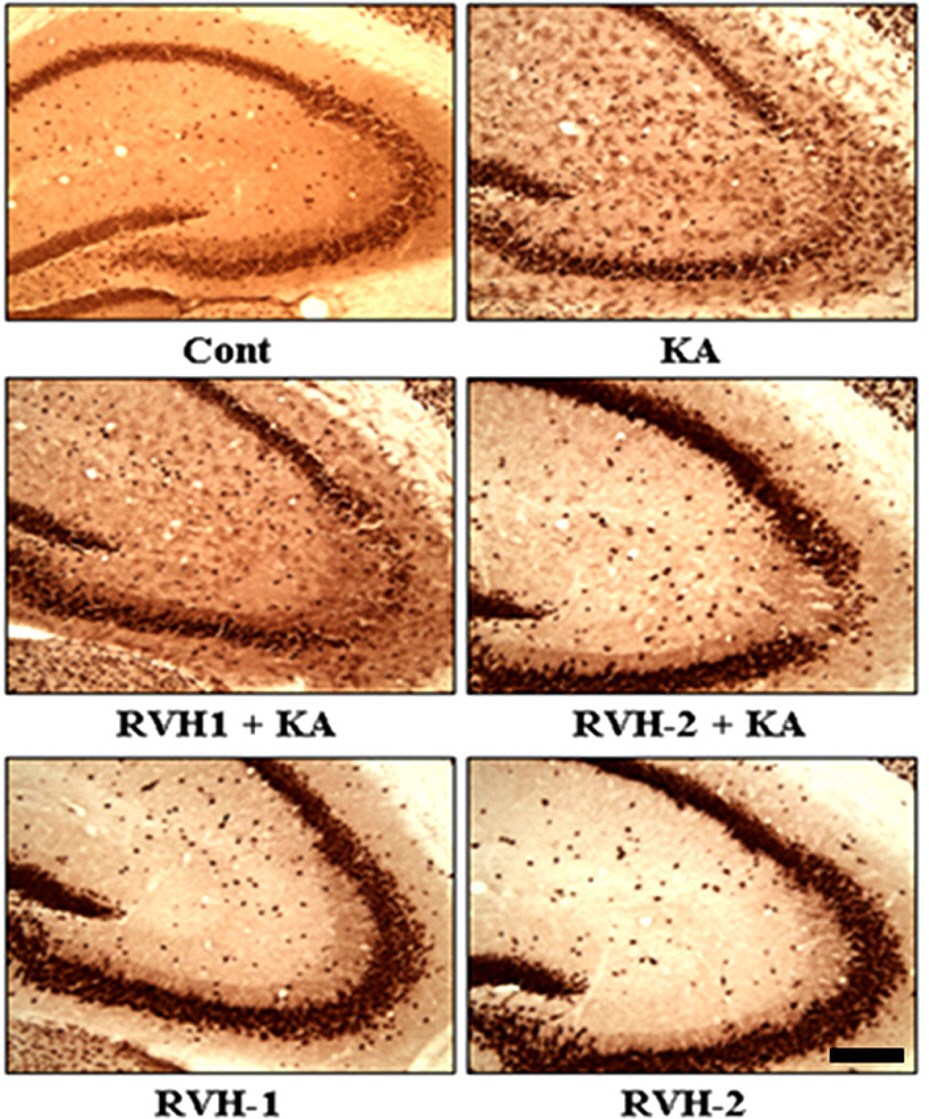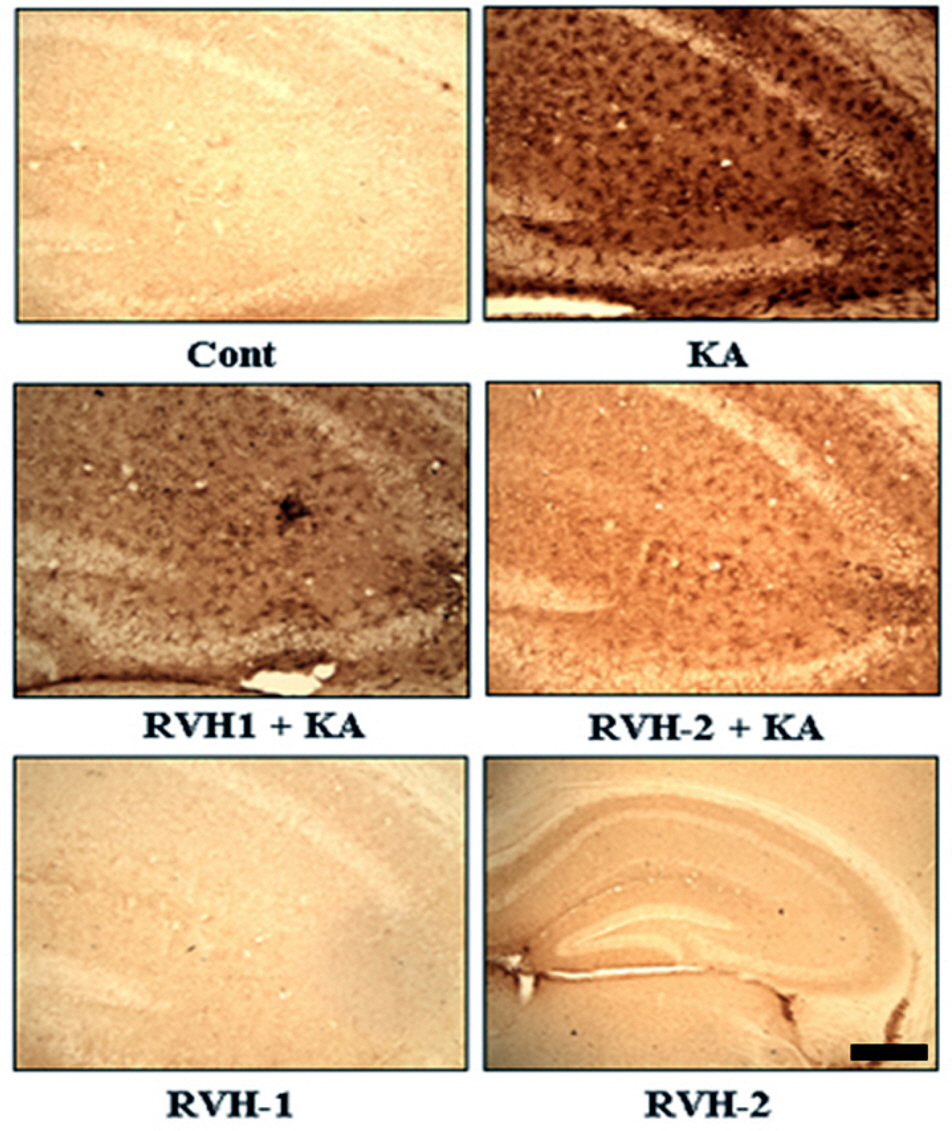Korean J Physiol Pharmacol.
2010 Oct;14(5):279-283. 10.4196/kjpp.2010.14.5.279.
Bark Constituents from Mushroom-detoxified Rhus verniciflua Suppress Kainic Acid-induced Neuronal Cell Death in Mouse Hippocampus
- Affiliations
-
- 1Department of Pharmacology, College of Medicine, Kangwon National University, Chuncheon 200-701, Korea. wchun@kangwon.ac.kr
- 2College of Pharmacy, Kangwon National University, Chuncheon 200-701, Korea.
- 3Division of Bio-resources Technology, Kangwon National University, Chuncheon 200-701, Korea. kimmjo@kangwon.ac.kr
- 4Department of Radiology, Ilsan Paik Hospital, Inje University, School of Medicine, Goyang 411-706, Korea.
- KMID: 2071694
- DOI: http://doi.org/10.4196/kjpp.2010.14.5.279
Abstract
- Urushinol, a plant allergen, has significantly restricted the medical application of Rhus verniciflua, although it has been reported to possess a wide variety of biological activities such as anti-inflammatory, antioxidant, and anti-cancer actions. To reduce the urushinol content while maintaining the beneficial biological activities, mushroom-mediated fermentation of Rhus verniciflua was carried out and this method resulted in significantly attenuated allergenicity [1]. In the present study, to examine the neuroprotective properties of mushroom-fermented stem bark of Rhus verniciflua, two constituents were isolated from mushroom-fermented bark and their neuroprotective properties were examined in a mouse model of kainic acid (KA)-induced excitotoxicity. KA resulted in significant apoptotic neuronal cell death in the CA3 region of mouse hippocampus. However, seven daily administrations of RVH-1 or RVH-2 prior to KA injection significantly attenuated KA-induced pyramidal neuronal cell death in the CA3 region. Furthermore, pretreatment with RVH-1 and RVH-2 also suppressed KA-induced microglial activation in the mouse hippocampus. The present study demonstrates that RVH-1 and RVH-2 isolated from Rhus verniciflua and detoxified using mushroom species possess neuroprotective properties against KA-induced excitotoxicity. This leads to the possibility that detoxified Rhus verniciflua can be a valuable asset in herbal medicine.
MeSH Terms
Figure
Reference
-
References
1. Choi HS. Biological Detoxification of Lacpuer Tree (Rhus verniciflua Stokes) Stem Bark by Mushroom Species. Food Science and Biotechnology. 2007; 16:935–942.2. Awad AB, Fink CS. Phytosterols as anticancer dietary components: evidence and mechanism of action. J Nutr. 2000; 130:2127–2130.
Article3. Martins SL, Silva HF, Novaes MR, Ito MK. Therapeutic effects of phytosterols and phytostanols in cholesterolemia. Arch Latinoam Nutr. 2004; 54:257–263.4. Gabay O, Sanchez C, Salvat C, Chevy F, Breton M, Nourissat G, Wolf C, Jacques C, Berenbaum F. Stigmasterol: a phytosterol with potential anti-osteoarthritic properties. Osteoarthritis Cartilage. 2010; 18:106–116.
Article5. Chung IM. Cytotoxic Chemical Constituents from the Mushroom of Pholiota adiposa. Food Science and Biotechnology. 2005; 14:255–258.6. Gupta S. Isolation and characterization of a dihydroxysterol from LAWSONIA INERMIS. Natural Product Letters. 1994; 4:195–201.7. Greca MD. Stigmasterols from Typha latifolia. J Nat Prod. 1990; 53:1430.8. Chang YC, Chang FR, Khalil AT, Hsieh PW, Wu YC. Cytotoxic Benzophenanthridine and Benzylisiquinoline Alkaloids from Argemone mexicana. Z Naturforsch C. 2003; 58:521–526.9. Itokawa H. Several oxidized sterols isolated from callus tissue of Stephania cepharantha. Chem Pharm Bull. 1973; 21:1386–1387.10. Choi DW, Rothman SM. The role of glutamate neurotoxicity in hypoxic-ischemic neuronal death. Annu Rev Neurosci. 1990; 13:171–182.
Article11. Doble A. The role of excitotoxicity in neurodegenerative disease: implications for therapy. Pharmacol Ther. 1999; 81:163–221.12. Izquierdo LA, Barros DM, Ardenghi PG, Pereira P, Rodrigues C, Choi H, Medina JH, Izquierdo I. Different hippocampal molecular requirements for short- and long-term retrieval of one-trial avoidance learning. Behav Brain Res. 2000; 111:93–98.
Article13. Byun JS, Lee SH, Jeon SH, Kwon YS, Lee HJ, Kim SS, Kim YM, Kim MJ, Chun W. Kainic Acid-induced Neuronal Death is Attenuated by Aminoguanidine but Aggravated by L-NAME in Mouse Hippocampus. Korean J Physiol Pharmacol. 2009; 13:265–271.
Article14. Giusti P, Lipartiti M, Franceschini D, Schiavo N, Floreani M, Manev H. Neuroprotection by melatonin from kainate-induced excitotoxicity in rats. FASEB J. 1996; 10:891–896.
Article15. Laursen SE, Belknap JK. Intracerebroventricular injections in mice. Some methodological refinements. J Pharmacol Methods. 1986; 16:355–357.16. Baker H, Farbman AI. Olfactory afferent regulation of the dopamine phenotype in the fetal rat olfactory system. Neuroscience. 1993; 52:115–134.
Article17. Henshall DC, Bonislawski DP, Skradski SL, Araki T, Lan JQ, Schindler CK, Meller R, Simon RP. Formation of the Apaf-1/cytochrome c complex precedes activation of caspase-9 during seizure-induced neuronal death. Cell Death Differ. 2001; 8:1169–1181.
Article18. Badria FA, Dawidar AA, Houssen WE, Shier WT. In vitro study of flavonoids, fatty acids, and steroids on proliferation of rat hepatic stellate cells. Z Naturforsch C. 2005; 60:139–142.
Article19. Nakai M, Qin ZH, Chen JF, Wang Y, Chase TN. Kainic acid-induced apoptosis in rat striatum is associated with nuclear factor-kappaB activation. J Neurochem. 2000; 74:647–658.20. Choi DW. Glutamate neurotoxicity and diseases of the nervous system. Neuron. 1988; 1:623–634.
Article21. Lee JM, Zipfel GJ, Choi DW. The changing landscape of ischaemic brain injury mechanisms. Nature. 1999; 399:A7–14.
Article22. McNamara JO. Emerging insights into the genesis of epilepsy. Nature. 1999; 399:A15–22.
Article23. Coyle JT, Puttfarcken P. Oxidative stress, glutamate, and neurodegenerative disorders. Science. 1993; 262:689–695.
Article24. Salinska E, Danysz W, Lazarewicz JW. The role of excitotoxicity in neurodegeneration. Folia Neuropathol. 2005; 43:322–339.25. Suzumura A, Takeuchi H, Zhang G, Kuno R, Mizuno T. Roles of glia-derived cytokines on neuronal degeneration and regeneration. Ann N Y Acad Sci. 2006; 1088:219–229.
Article26. Milatovic D, Gupta RC, Dettbarn WD. Involvement of nitric oxide in kainic acid-induced excitotoxicity in rat brain. Brain Res. 2002; 957:330–337.
Article27. Dehmer T, Lindenau J, Haid S, Dichgans J, Schulz JB. Deficincye of inducible nitric oxide synthase protects against MPTP toxicity in vivo. J Neurochem. 2000; 74:2213–2216.28. Kim YM, Bombeck CA, Billiar TR. Nitric oxide as a bifunctional regulator of apoptosis. Circ Res. 1999; 84:253–256.
Article29. Sugimoto K, Iadecola C. Effects of aminoguanidine on cerebral ischemia in mice: comparison between mice with and without inducible nitric oxide synthase gene. Neurosci Lett. 2002; 331:25–28.
Article
- Full Text Links
- Actions
-
Cited
- CITED
-
- Close
- Share
- Similar articles
-
- Kainic Acid Treatment Increases Ca²âº-mediated Neurotoxicity in the Mouse Hippocampus
- Glycyrrhizin Attenuates Kainic Acid-Induced Neuronal Cell Death in the Mouse Hippocampus
- Protective Effect of Etomidate on Kainic Acid-induced Neurotoxicity in Rat Hippocampus
- Cilostazol attenuates kainic acid-induced hippocampal cell death
- Kainic Acid-induced Neuronal Death is Attenuated by Aminoguanidine but Aggravated by L-NAME in Mouse Hippocampus






